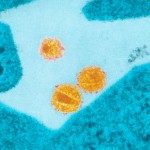Lien vers Pubmed [PMID] – 21858022
PLoS ONE 2011;6(8):e23185
BACKGROUND: Idiopathic pulmonary fibrosis is a devastating as yet untreatable disease. We demonstrated recently the predominant role of the NLRP3 inflammasome activation and IL-1β expression in the establishment of pulmonary inflammation and fibrosis in mice.
METHODS: The contribution of IL-23 or IL-17 in pulmonary inflammation and fibrosis was assessed using the bleomycin model in deficient mice.
RESULTS: We show that bleomycin or IL-1β-induced lung injury leads to increased expression of early IL-23p19, and IL-17A or IL-17F expression. Early IL-23p19 and IL-17A, but not IL-17F, and IL-17RA signaling are required for inflammatory response to BLM as shown with gene deficient mice or mice treated with neutralizing antibodies. Using FACS analysis, we show a very early IL-17A and IL-17F expression by RORγt(+) γδ T cells and to a lesser extent by CD4αβ(+) T cells, but not by iNKT cells, 24 hrs after BLM administration. Moreover, IL-23p19 and IL-17A expressions or IL-17RA signaling are necessary to pulmonary TGF-β1 production, collagen deposition and evolution to fibrosis.
CONCLUSIONS: Our findings demonstrate the existence of an early IL-1β-IL-23-IL-17A axis leading to pulmonary inflammation and fibrosis and identify innate IL-23 and IL-17A as interesting drug targets for IL-1β driven lung pathology.



